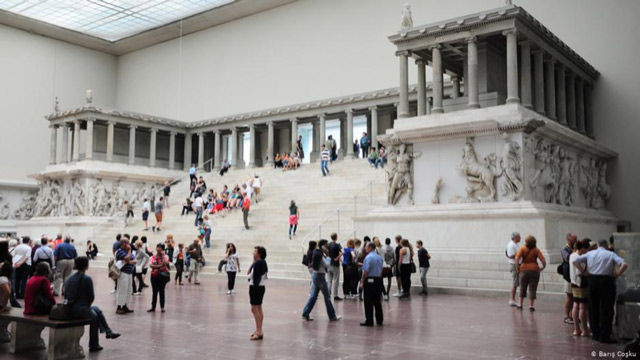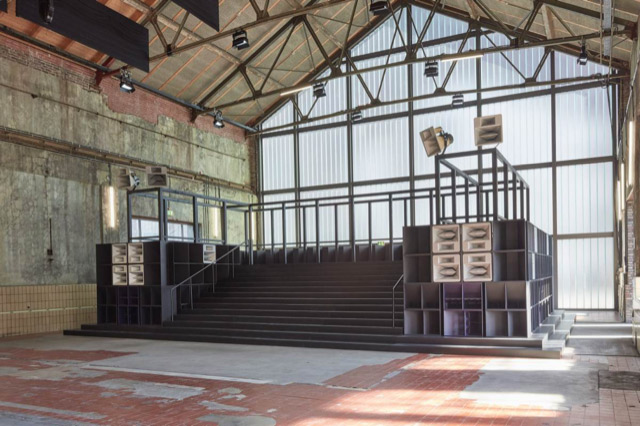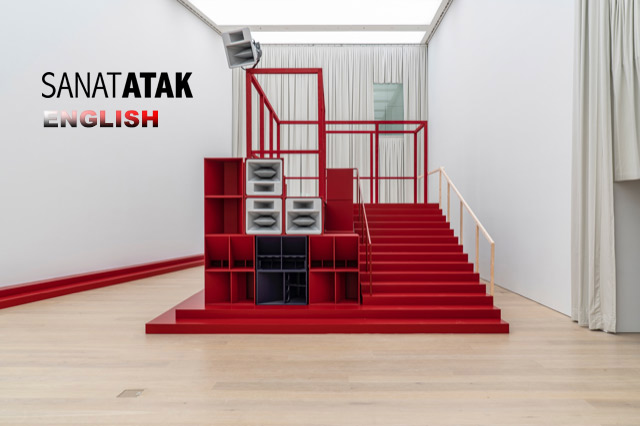With his solo exhibition Bergama Stereotip, Cevdet Erek brings the past into the present with his large-scale audio-visual installation, a reinterpretation of the Great Altar of Pergamon, which in 1871 was excavated from Turkey’s Aegean coast and brought to Berlin. But with Cevdet Erek’s contemporary version specifically designed for Arter and with help from curator Selen Ansen, the Great Altar has now finally returned to Turkey.
The architectural construction of multilayered blocks fills up Arter’s gallery space, both with its large-scale dimensions, as well as with its use of a 13-channel audio sound system, which sends vibrations through the room and trembles the approaching audience. Bergama Stereotip, is Erek’s take on turning the Great Altar of Pergamon into a sonic paraphrase of the historical edifice. The work is also a continuation of Bergama Stereo, a previous version of the artwork, which was exhibited first at Ruhrtriennale in Bochum, and then at Hamburger Bahnhof in Berlin, as a part of the series Works of Music by Visual Artists. Bergama Stereotip refers back to both the previous version, as well as the historic altar – both distancing itself by reemerging in a new version, as well as drawing upon its previous sources, and hereby bringing together different temporalities and spaces.

The Great Altar of Pergamon, Pergamonmuseum, Staatliche Museen zu Berlin, (Photo: Barış Coşku)
When the Great Altar, an open-air monument from around the 2nd century BC, was discovered in the ancient city of Pergamon (present-day Bergama in the province of Izmir) and brought to Berlin for reconstruction, a frieze which had adorned the altar with dramatic baroque reliefs revealed itself. It depicted the battle between the underground Giants, and the celestial Olympian gods – one of the greatest works of Hellenistic art, which have ever since, been on view at the Pergamonmuseum.
Echoing the battle between the giants and the gods
But what was once visually depicted in the Grand Frieze, is now turned into an audial depiction in Bergama Stereotip. The figurative reliefs are switched out with speakers which all projects different sound compositions of short, repetitive beats, resembling sounds of the contemporary clubbing scene. It emphasizes the architectural construction as the sound is travelling around the space, echoing the battle between the giants and the gods, but constantly changing, fading in and out, due to the audience’s movement in the room.
Bergama Stereotip first truly emerges in this meeting with its audience, but this interaction also becomes its challenge, as it makes the work very dependent on the viewer. In the interplay between audio and architecture, the audience have to let go of the established habits of approaching an art work as purely visual. You have to walk, sit, talk, go up and look from the platform, take a seat at the staircase which frames the whole gallery space. Use the space, and the changing tempo and feeling of the beats will bring the mythological battle between the giants and the gods, right into Arter’s gallery space 1.
Bergama Stereotip shows that the artist behind is not a product of the traditional art and gallery system. Erek is interested in audio and architecture, and by combining it with historicity, he invites the viewer to reflect on our perception and experience of a given time and space. The visual components interact with the audio, turning sound into a visual dimension and the visual into an audial dimension. The mythological battle of the Grand Frieze isn’t described, but on the contrary translated into a contemporary form. The past is brought into the present, and manifested, temporally and spatially.
They are all connected

Cevdet Erek, Bergama Stereo, Ruhrtriennale Bochum 2019, (Photo: Michael Godehardt)
And by reflecting back on both the previous version of the work, as well as the historic altar, Bergama Stereotip provides the audience with several options for interpretation. The Great Altar has found itself going from Pergamon to Bochum, to Berlin, to Istanbul. They are all connected, and draws upon the same source, which is also indicated in the title of the works. While the previous version, Bergama Stereo, relates the architectural symmetry of the historical altar, to the acoustic symmetry of the stereo sound, Bergama Stereotip, relates to the concept of “stereotype”, an idea of repetition and reproduction. But they do also differentiate.
In Istanbul, Bergama Stereotip has developed a red appearance, to adapt to the traditional wooden houses of the city. While the previous version in Bochum, Bergama Stereo, consisted of an all-black look, adopting the color of coal, reminiscing the city’s industrial past. The differentiation is necessary for the continuation of the work, which becomes a story of historical displacement, were all versions must transform and take a distance from each other, in order to fit into different and foreign places.
By doing so, Cevdet Erek has translated a part of the history into an audible abstraction, and managed to change the scale and look of the historical altar, but without letting it lose its monumentality. The past is brought into the present, and reshaped as the audio develop and merge around the audience, making it possible to leave traces of your own body in space.
Bergama Stereotip by Cevdet Erek will be on view at Arter, until 9th of August, 2020.


